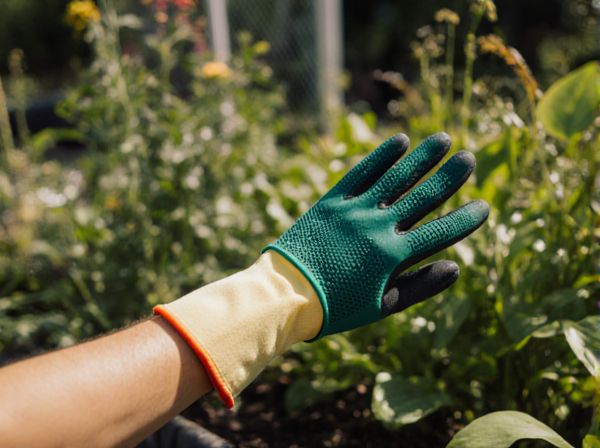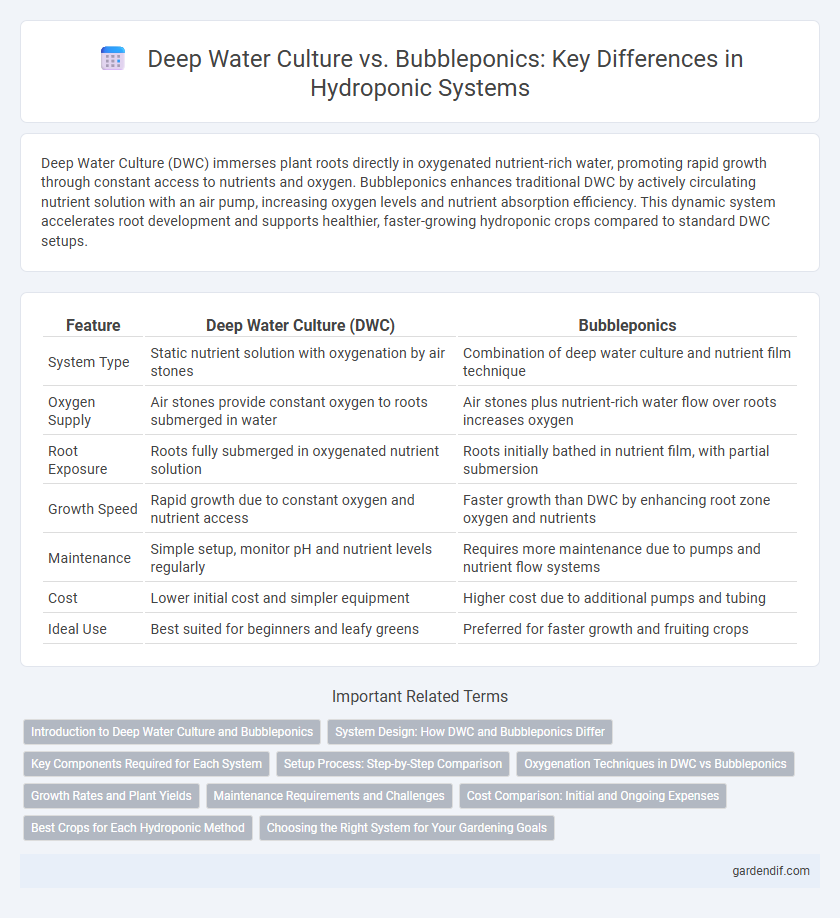
Deep Water Culture vs Bubbleponics Illustration
Deep Water Culture (DWC) immerses plant roots directly in oxygenated nutrient-rich water, promoting rapid growth through constant access to nutrients and oxygen. Bubbleponics enhances traditional DWC by actively circulating nutrient solution with an air pump, increasing oxygen levels and nutrient absorption efficiency. This dynamic system accelerates root development and supports healthier, faster-growing hydroponic crops compared to standard DWC setups.
Table of Comparison
| Feature | Deep Water Culture (DWC) | Bubbleponics |
|---|---|---|
| System Type | Static nutrient solution with oxygenation by air stones | Combination of deep water culture and nutrient film technique |
| Oxygen Supply | Air stones provide constant oxygen to roots submerged in water | Air stones plus nutrient-rich water flow over roots increases oxygen |
| Root Exposure | Roots fully submerged in oxygenated nutrient solution | Roots initially bathed in nutrient film, with partial submersion |
| Growth Speed | Rapid growth due to constant oxygen and nutrient access | Faster growth than DWC by enhancing root zone oxygen and nutrients |
| Maintenance | Simple setup, monitor pH and nutrient levels regularly | Requires more maintenance due to pumps and nutrient flow systems |
| Cost | Lower initial cost and simpler equipment | Higher cost due to additional pumps and tubing |
| Ideal Use | Best suited for beginners and leafy greens | Preferred for faster growth and fruiting crops |
Introduction to Deep Water Culture and Bubbleponics
Deep Water Culture (DWC) is a hydroponic method where plant roots are suspended in oxygen-rich nutrient solution, promoting rapid growth and efficient nutrient uptake. Bubbleponics enhances DWC by combining a nutrient film of aerated solution circulated around the roots, increasing oxygen availability and nutrient absorption. Both systems maximize oxygen delivery but differ in nutrient flow dynamics, impacting growth rates and system maintenance.
System Design: How DWC and Bubbleponics Differ
Deep Water Culture (DWC) systems suspend plant roots directly in oxygenated nutrient-rich water, using air stones or diffusers to supply oxygen, creating a simple and effective design focused on constant root immersion. Bubbleponics enhances the DWC design by combining this deep root submersion with targeted water circulation near the root zone using water pumps or bubbler nozzles, promoting faster nutrient uptake and oxygen delivery. This difference in system design results in Bubbleponics providing a more dynamic nutrient flow and oxygen enrichment while maintaining the core principles of DWC's suspended root structure.
Key Components Required for Each System
Deep Water Culture requires an air pump, air stone, and nutrient-rich oxygenated water to keep plant roots suspended and oxygenated. Bubbleponics combines these components with a water pump to deliver nutrient solution actively to the root zone, enhancing oxygen and nutrient uptake. Both systems depend on reservoirs and grow trays, but Bubbleponics demands increased circulation infrastructure for improved root aeration and nutrient distribution.
Setup Process: Step-by-Step Comparison
Deep Water Culture (DWC) setup involves submerging plant roots directly in an oxygen-rich nutrient solution using air stones and a reservoir, requiring minimal components such as an air pump, tubing, and net pots. Bubbleponics enhances DWC by adding a water pump to circulate nutrient solution towards roots, accelerating oxygen and nutrient delivery, and necessitates extra steps like installing the circulation system. Both methods start with seedling preparation and reservoir filling, but Bubbleponics demands more intricate plumbing and monitoring to maintain optimal flow and aeration levels.
Oxygenation Techniques in DWC vs Bubbleponics
Deep Water Culture (DWC) utilizes airstones connected to air pumps to continuously oxygenate the nutrient solution, ensuring roots receive ample dissolved oxygen for optimal growth. In contrast, Bubbleponics integrates both airstones for root oxygenation and active water circulation near the root zone, enhancing nutrient uptake and preventing stagnation. This dual oxygenation technique in Bubbleponics promotes faster root development and improved plant health compared to traditional DWC systems.
Growth Rates and Plant Yields
Deep Water Culture (DWC) systems provide steady oxygen supply to roots, promoting rapid growth rates for leafy greens and herbs, often resulting in increased biomass within weeks. Bubbleponics enhances traditional DWC by actively aerating the nutrient solution around young root zones, accelerating nutrient uptake and improving early-stage growth speed, which can lead to higher overall plant yields. Studies indicate Bubbleponics typically outperforms standard DWC in growth velocity and crop production efficiency, especially during initial growth phases.
Maintenance Requirements and Challenges
Deep Water Culture (DWC) systems require regular monitoring of water pH, oxygen levels, and nutrient concentration to prevent root rot and nutrient deficiencies, with air pumps needing consistent maintenance to ensure adequate oxygenation. Bubbleponics demands more intensive upkeep as it combines nutrient film technique (NFT) pumps with aerated deep water, making pump reliability and nutrient film flow rate critical for optimal root zone oxygenation and nutrient delivery. Both systems face challenges such as algae growth and system clogs, though Bubbleponics often requires more frequent inspection to manage the dual-component infrastructure effectively.
Cost Comparison: Initial and Ongoing Expenses
Deep Water Culture (DWC) systems typically have lower initial setup costs due to their simple design, requiring only a reservoir, net pots, and an air pump, whereas Bubbleponics demands additional components like a water pump and growing trays, increasing upfront expenses. Ongoing costs for DWC remain minimal, mainly electricity for aeration, while Bubbleponics incurs slightly higher electricity usage from continuous water circulation and maintenance of both air and water pumps. Budget-conscious growers often prefer DWC for its affordability and straightforward operation, but Bubbleponics offers enhanced root oxygenation at a moderately higher cost.
Best Crops for Each Hydroponic Method
Leafy greens like lettuce, spinach, and kale thrive in Deep Water Culture (DWC) systems due to their need for consistent oxygenation and nutrient delivery in a stable water environment. Bubbleponics, combining nutrient film technique and air bubblers, excels with fast-growing, nutrient-demanding crops such as tomatoes, peppers, and cucumbers, benefiting from enhanced root oxygenation and nutrient uptake. Root vegetables like radishes and herbs such as basil perform well in both systems, but their growth speed and yield can vary based on oxygen levels and nutrient availability specific to each hydroponic method.
Choosing the Right System for Your Gardening Goals
Deep Water Culture (DWC) offers a simple, cost-effective solution with roots suspended directly in oxygenated nutrient-rich water, ideal for beginners and fast-growing crops. Bubbleponics enhances traditional DWC by adding a water pump and drip system to deliver nutrients to the root zone more efficiently, promoting faster growth and higher yields. Selecting the right system depends on your budget, space, crop type, and desired growth rate to maximize plant health and productivity.
Deep Water Culture vs Bubbleponics Infographic

 gardendif.com
gardendif.com